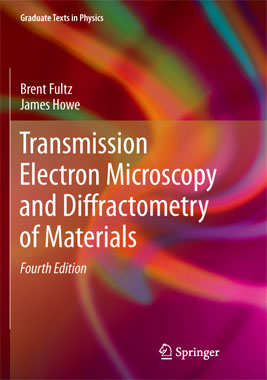





Brent Fultz and Jim Howe
Compared to the first edition, the second includes many re-writings to improve clarity, ranging from substantial re-structurings to subtle re-wordings. It has many improved explanations, and new content on high resolution microscopy and Z-contrast imaging. Errors in the text and figures were corrected over the course of several critical re-readings, classroom teaching, and feedback from readers across the world. The online solutions manual was updated, too.
Although the number of pages in the first and second editions are essentially the same, the conservation of pages was obtained in part by a large number of deletions and condensations of wordy explanations. The equations were typeset with less vertical clearance (owing to the use of eqnarray rather than equation in LaTeX). The net amount of content has increased by about two or three percent, but with deletions, additions and rewordings, the overall amount of changed text is probably closer to ten percent. Nevertheless, the topics and structure of the first edition remained intact.
The third edition of the book evolved similarly. Generally the text was shortened as we as we found more clever explanations, and phrasings were improved from the second edition. The method of high resolution high-angle annular dark field imaging was separated into its own chapter, which includes new content on theory and on Cs correctors for the TEM. The section on the Warren-Averbach method was deleted, but a modern discussion on Huang scattering was added. There are many other such changes throughout the text, but the overall length is only a few pages more. For the third edition, the authors were able to work more effectively with the publisher to optimize the gray scale in the halftone printing, improving the image clarity. The second printing of the second edition is still quite good as a textbook. If you have the first edition of the text, however, you really should get the third edition. The third edition is significantly better than the first edition, being more concise, accurate, up to date, and beautiful.
The fourth edition has more additions than deletions and is a bit longer than the third. The new chapter 3 on neutron scattering follows the descriptions of x-ray and electron scattering of chapters 1 and 2. Descriptions of new experimental techniques on tomography and nanobeam diffraction were added. Comments from students led to subtle rewordings of many problems to remove ambituities. This edition, unlike the previous three, was not typeset by the authors, but by VTeX Book Production under a subcontract with Springer. They did a fine job with the compositing and finding small errors in cross-references, in particular. The fourth edition is the cleanest edition of the book in both appearance and in the absence of typographical errors.